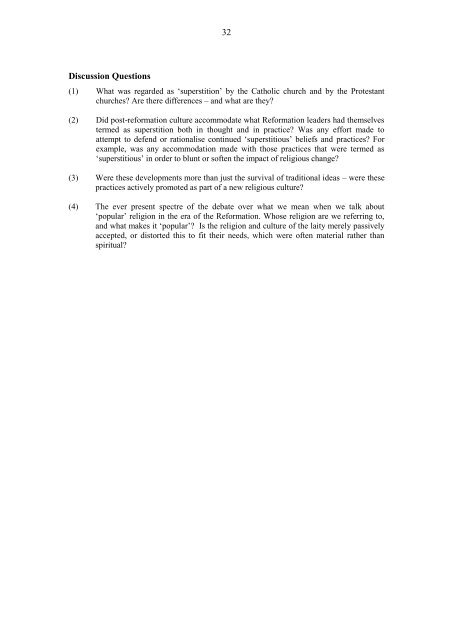Ritual, Myth and Magic in Early Modern Europe - University of Reading
Ritual, Myth and Magic in Early Modern Europe - University of Reading
Ritual, Myth and Magic in Early Modern Europe - University of Reading
You also want an ePaper? Increase the reach of your titles
YUMPU automatically turns print PDFs into web optimized ePapers that Google loves.
32<br />
Discussion Questions<br />
(1) What was regarded as ‗superstition‘ by the Catholic church <strong>and</strong> by the Protestant<br />
churches? Are there differences – <strong>and</strong> what are they?<br />
(2) Did post-reformation culture accommodate what Reformation leaders had themselves<br />
termed as superstition both <strong>in</strong> thought <strong>and</strong> <strong>in</strong> practice? Was any effort made to<br />
attempt to defend or rationalise cont<strong>in</strong>ued ‗superstitious‘ beliefs <strong>and</strong> practices? For<br />
example, was any accommodation made with those practices that were termed as<br />
‗superstitious‘ <strong>in</strong> order to blunt or s<strong>of</strong>ten the impact <strong>of</strong> religious change?<br />
(3) Were these developments more than just the survival <strong>of</strong> traditional ideas – were these<br />
practices actively promoted as part <strong>of</strong> a new religious culture?<br />
(4) The ever present spectre <strong>of</strong> the debate over what we mean when we talk about<br />
‗popular‘ religion <strong>in</strong> the era <strong>of</strong> the Reformation. Whose religion are we referr<strong>in</strong>g to,<br />
<strong>and</strong> what makes it ‗popular‘? Is the religion <strong>and</strong> culture <strong>of</strong> the laity merely passively<br />
accepted, or distorted this to fit their needs, which were <strong>of</strong>ten material rather than<br />
spiritual?

















